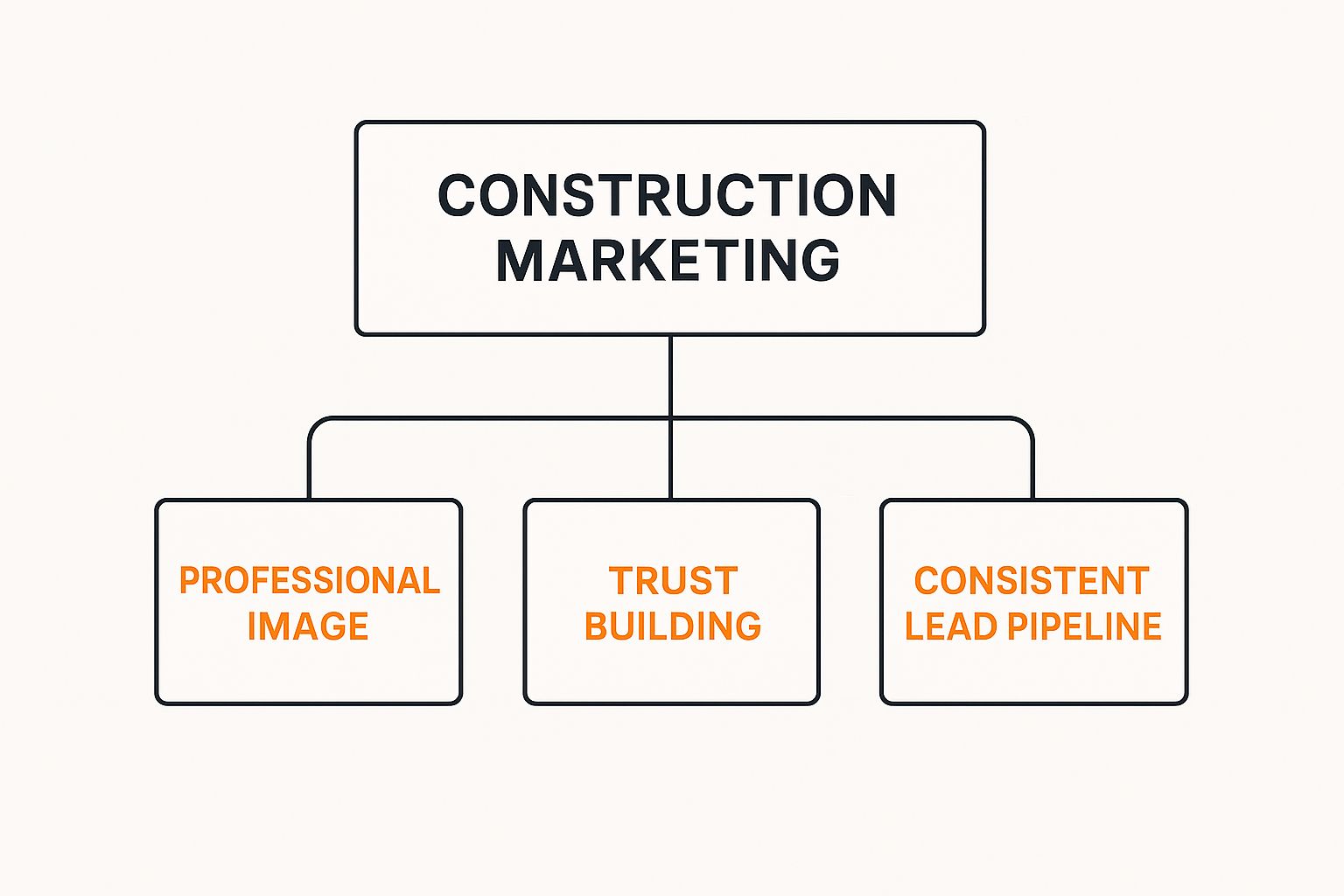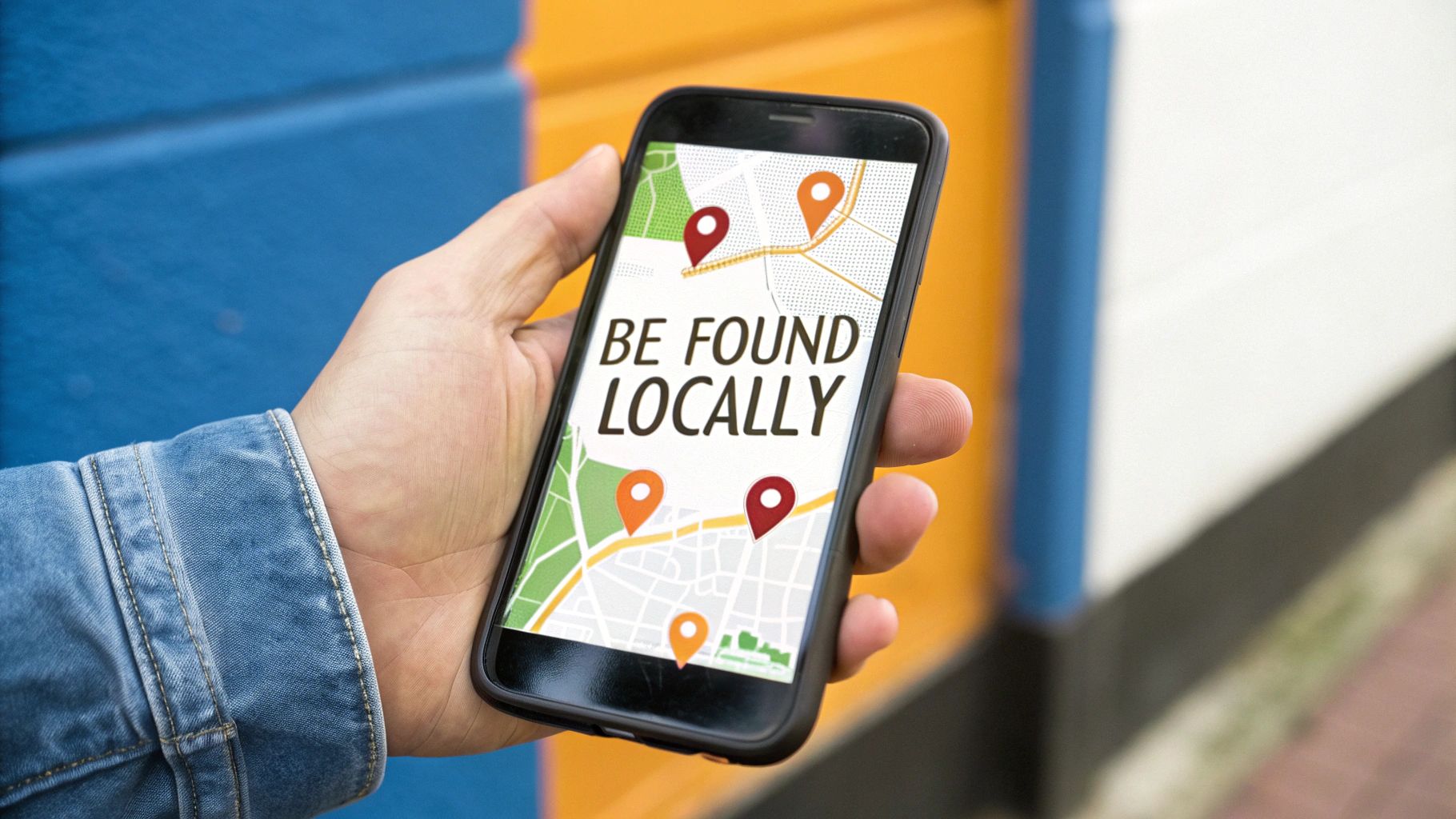


Construction marketing isn't just sticking a logo on a ute and hoping for the best. It's your complete system for building a rock-solid reputation that consistently brings the right kind of clients to your door. It’s about taking control so you’re not waiting for the phone to ring.
Let’s be honest, relying on word-of-mouth alone is a risky game. In a world where 81% of buyers jump online to do their homework before making any big decisions, you need to be there, looking professional and trustworthy.
Think of your marketing plan as the blueprint for your business's growth. It’s not about flashy ads or complicated jargon. It’s a practical set of tools designed to make you look professional, build trust with potential clients, and keep your pipeline filled with profitable jobs—not just tyre-kickers.
Without a plan, your business growth is left to chance. Sure, you might get a few referrals, but you have no control over when they come in or what kind of work they bring. A smart marketing system puts you in the driver's seat.
Relying solely on referrals is like building a house on a shaky foundation. It might hold up for a while, but it’s unstable and unpredictable. A strong marketing system gives you direct control over your lead flow, ensuring you have a steady stream of quality enquiries coming your way.
Here’s a quick comparison showing the difference between passively waiting for work and actively building a pipeline.
The modern approach is all about proactive growth, and it starts with your online presence.
A huge piece of the puzzle is understanding What Is Reputation Management and Why Does It Matter? for the long-term health of your business. Your reputation is your most valuable asset, and marketing is how you build, protect, and showcase it online.
The infographic below nails down the three core outcomes of great construction marketing.

As you can see, everything you do in your marketing should aim to strengthen your professional image, build genuine trust, and ultimately, drive a consistent flow of high-quality leads.
Having a deliberate marketing strategy becomes even more critical when the market gets tight. Recent forecasts show the New Zealand construction sector is facing a temporary dip, with residential building work expected to drop by 7.2%.
But here's the good news: the sector is predicted to bounce back, with an average annual growth of 5.6% from 2025 to 2029.
This downturn is precisely when the best builders double down on their brand. When work is scarcer, clients become far more selective. They don't just look for any builder; they look for the most credible and professional builder they can find.
This is where marketing gives you an advantage. It ensures your business stands out as the obvious choice, helping you capture market share while your competitors sit back and wait. It positions you to not only survive the dip but to lead the charge when the market recovers.
To get a better idea of how marketing can elevate your brand, have a look at our overview of Onsite Media in New Zealand. By investing in your brand now, you build the momentum needed to capitalise on future growth, turning market uncertainty into your biggest competitive edge.

Think of your website as your hardest-working salesperson. It’s on the job 24/7 and is focused on one thing: convincing potential clients you’re the right builder for their project. This isn't just an online brochure; it's a lead-generating machine.
A solid website does more than just list your services—it proves your worth. When a homeowner is about to invest hundreds of thousands of dollars into a renovation or new build, their research almost always starts online. Your website is where they’ll form that crucial first impression.
This is your digital storefront. It needs to look the part, work flawlessly, and build trust from the first click.
Long before a potential client reads a single word, they’ll judge you on your photos. In the building game, seeing is believing. That makes professional project photography an absolute non-negotiable.
Grainy, poorly lit phone snaps scream amateur. Crisp, high-quality images of your finished projects signal professionalism and attention to detail. It’s the fastest way to build credibility.
Your website’s photo gallery is your digital portfolio. It’s not just a collection of pictures; it’s tangible proof of your craftsmanship. Invest in it accordingly.
When showing off your work, remember that clients are looking for transformations. A gallery of a finished coastal renovation in Mount Maunganui or a new build in Tauranga needs to tell a story of quality, from the foundations to the final coat of paint. This is the visual proof that gets them to pick up the phone.
Once your photos have caught their eye, your words need to hold their attention. Your service descriptions shouldn't be a dry list of what you do. They need to connect with your client’s problems and hopes.
So, instead of a heading that just says "Kitchen Renovations," talk about how you create functional, beautiful spaces for growing families. This shows you understand what they’re really after, and that builds trust.
Here’s what your key website pages need to nail:
Most of your potential clients will find you on their mobile. If your website is a clumsy, hard-to-use mess on a small screen, they’re gone. In fact, more than 50% of users will ditch a site that isn’t mobile-friendly.
Your site must be responsive, meaning it automatically adjusts to fit any screen. Text needs to be easy to read, buttons easy to tap, and your images must load quickly.
A clunky mobile experience is the digital equivalent of turning up to a client meeting in a dirty ute. It sends the wrong signals and kills your credibility, costing you leads before you even knew they were there.
Search Engine Optimisation, or SEO, sounds complex, but the idea is simple. When a potential client in your area googles "custom home builder Christchurch" or "kitchen renovations Auckland," you want your company to pop up first. It’s the digital version of having the best sign on the busiest road in town.
At its core, SEO is the process of making your website more attractive to search engines like Google. It sends signals that prove your business is a legitimate, trustworthy answer to what someone is looking for. Without it, your new website is basically invisible.
Good construction marketing is about being seen by the right people at the exact moment they need you. SEO is the most powerful tool you have to make that happen.
The foundation of good SEO is understanding the exact phrases your ideal clients are typing into Google. These are called keywords. You might call yourself a "bespoke residential construction specialist," but your clients are far more likely to be searching for "new builds Queenstown."
Getting this right is critical. Put yourself in the homeowner's shoes. What problem are they trying to solve?
Here are a few common keyword patterns for builders:
Once you identify these terms, build your website content around them. This shift ensures you attract qualified traffic—people actively looking for the services you provide—turning your website into a genuine lead-generation tool.
Once you have your keywords, the next job is to weave them naturally into your website. This is called on-page SEO. It’s all about making it crystal clear to Google what each page on your site is about.
Your website needs a logical structure so that search engines can easily "read" its content. This isn't just for bots. A well-organised site is also easier for visitors to navigate, which helps build trust and makes them more likely to pick up the phone.
A website without on-page SEO is like a blueprint with no labels. All the essential information might be there, but nobody can make sense of it. Clear labelling helps both Google and your clients understand exactly what you do.
Key on-page elements include your page titles, headings, and the actual text. For instance, if you’re targeting "kitchen renovations Hamilton," your page title should say exactly that. Your content should then answer the common questions a client might have about the process.
While on-page SEO is about what's on your site, off-page SEO is about building your authority elsewhere on the web. Put simply, it’s about earning "votes of confidence" from other reputable websites.
In the building world, a strong recommendation from a trusted architect is gold. Online, a link from their website to yours works the same way. These links, called backlinks, are a massive signal to Google that your business is a respected player in the industry.
Here are a few practical ways to build your off-page presence:
Every one of these actions strengthens your online reputation, making your business look more authoritative in Google's eyes. Over time, this helps you rank higher, drive more traffic, and win more high-value projects.

In the building trade, seeing is believing. Your craftsmanship speaks for itself on-site, but online, you need visuals that do the talking for you.
Honestly, a single, high-quality photograph of a finished project is more convincing than a whole page of text.
Visuals are the most powerful tool in your construction marketing toolbox. They build instant credibility and show potential clients exactly what you’re capable of. Without strong photos and videos, you’re asking people to take your word for it, while competitors are proving their value with killer imagery.
This isn’t about snapping a few quick pictures on your phone. It’s about building a professional portfolio that helps you win bigger and better projects.
Hiring a professional photographer isn't a cost—it's an investment that pays for itself. A pro knows how to capture the right light, the best angles, and the small details that make your work look as impressive online as it does in person.
They turn a well-built structure into a story of quality.
Put yourself in the client’s shoes. They’re scrolling through websites, trying to choose a builder for a massive investment. What stands out? It’s not the poorly lit phone snaps. It’s the crisp, professional shots of a stunning coastal renovation or a perfectly finished new build in Tauranga.
These images immediately signal that you’re a serious, high-calibre operator. They build trust and justify a premium price point before you’ve even had a conversation.
Great visual content does more than just show off the final product; it tells a story of transformation. This is how you connect with clients on an emotional level, helping them envision what’s possible for their own home.
Here are a few proven ways to use visuals to tell a compelling story:
Your portfolio should do more than just document your work—it should sell it. Every photo and video is a chance to prove your expertise, showcase your quality, and build the trust needed to turn a visitor into a lead.
Once you have a library of high-quality visuals, put them to work across all your marketing channels. Your visuals are the fuel for your entire online presence.
Even with market uncertainties, visuals help you stand out. The BDO Construction Sector Report shows that while challenges exist, leaders are optimistic about future growth. Powerful visuals ensure you’re the one they call.
For more ideas on how to use content to launch your brand forward, check out our insights on partnering with a launch agency. By consistently showcasing your best work with professional visuals, you build a powerful brand that attracts the right clients, no matter what the market is doing.

For most builders, the best clients are just around the corner. While a sharp website is crucial, your Google Business Profile (GBP) is the most powerful free tool you have for winning your local patch. It’s what puts your company on the map—literally.
When a homeowner in your suburb searches for a "builder near me," what do they see first? It’s the Google "map pack," a small selection of top-rated local businesses. Getting into that prime digital real estate can drive a steady stream of quote requests straight to your phone.
Your GBP and your website work as a team. Neglecting your profile is like building a beautiful showroom but keeping the doors locked.
Your Google Business Profile is your digital front door. It's often the first impression a potential client gets. That means every detail needs to be accurate, professional, and complete.
Your company name, address, and phone number need to be perfectly consistent everywhere they appear online. Google rewards this because it proves you're a real business. From there, fill out every single section of your profile.
A half-finished Google profile sends a terrible message. It suggests a lack of attention to detail—the last thing you want a client thinking before they trust you with a six-figure renovation.
The goal is simple: give Google as much quality information as you can. Make it easy for its algorithm to understand what you do, where you do it, and why you’re the best choice for homeowners in the area.
Getting to the top of Google Maps isn’t about secret tricks. It's about doing the simple things right, over and over again. A fully optimised profile is your foundation.
This isn’t rocket science. It’s about being thorough. Here's a simple checklist to make sure your profile is dialled in.
Working through this checklist builds a rock-solid profile that Google will favour when a local customer needs your services.
If one thing moves the needle more than anything else for your local ranking, it’s a steady stream of glowing client reviews. Reviews are pure social proof. They build immense trust and are a huge ranking signal for Google.
Getting reviews can't be left to chance. You need a simple process. The perfect time to ask is right after the final walkthrough when the client is thrilled. Send them a direct link to your Google review page to make it as easy as possible.
Consistently earning five-star reviews will do more for your local visibility than almost any other marketing activity. For a deeper dive, check out this excellent guide to dominating your Google Maps ranking—it breaks down all the key factors.
A solid plan separates intentions from results. This is where we pull everything together into a practical framework for a busy builder.
The goal isn't to do everything at once. It's about building a sustainable marketing engine that keeps the right kind of leads coming in.
Think of it like building a house. You don't start framing before the foundations are poured. Marketing works the same way. Nail the foundational pieces first, then add other elements over time.
This measured approach stops you from getting overwhelmed. Instead, you're methodically building a system that wins you work and gives you control over your company's future.
Before you think about posting on social media, get these two core assets dialled in. They are the bedrock of your entire marketing effort.
Get these wrong, and everything else is an uphill battle.
Your Professional Website: This is your digital storefront. It needs to show off your best work with high-quality photos, clearly explain what you do, and make it simple for clients to get in touch. Your website works for you 24/7 to build credibility.
Your Google Business Profile: This is your key to winning the local game. A fully optimised profile stacked with five-star reviews is what gets you seen by homeowners actively searching for a builder in your area. It’s the most powerful free marketing tool you have.
Nail these two things first. A great website proves your quality, and a strong Google profile ensures local clients can find you. Get these right, and you’ll already be ahead of most of your competition.
Once your foundations are solid and bringing in enquiries, it's time to expand your reach. This is where you begin to actively broadcast your expertise and build a stronger brand.
Make sure Phase 1 is sorted first.
This is also where paying attention to the market matters. The value of building work consented in New Zealand has recently dipped. In a tighter market, active marketing is what keeps a steady pipeline of work coming your way. You can learn more about these trends in the NZ construction sector.
Here’s what to focus on next:
Consistent Social Media: Start sharing your best project photos and videos on platforms like Instagram or Facebook. This isn't about posting every day. It’s about consistently showing off your craftsmanship. For more detailed strategies, our guide to social media management in NZ has practical advice.
Email Marketing: Start collecting email addresses from your website enquiries. A simple monthly email—sharing a recently finished project or a helpful tip—is a powerful way to stay top-of-mind with potential clients and architects.
This step-by-step game plan shifts you from passively taking whatever work comes along to actively shaping your company's growth. It’s about building a reliable system for attracting the right clients, no matter what the market is doing.
We get it. Stepping into marketing can feel like laying the groundwork for a new kind of build, and it’s natural to have questions. Here are some straight-up answers to the things we hear most often.
No jargon, no fluff—just practical advice.
There’s no one-size-fits-all answer, but a solid rule of thumb is to set aside 3-5% of your annual revenue.
If you're really looking to make a splash, especially in a competitive spot like Auckland or Queenstown, you’ll want to push that closer to 7-10%. That’s the kind of budget that gives you the firepower to lead the pack.
Think of it this way: it’s not a cost, it’s an investment in getting better work. Good marketing attracts the high-value, profitable projects you really want.
Marketing isn’t an overnight fix, but some wins come quicker than you might think. Getting the basics right, like optimising your Google Business Profile, can have the phone ringing with local enquiries within 30-90 days.
Other strategies, like SEO, are a long game. It's like pouring a concrete slab—it takes time to cure, but once it’s set, it provides a rock-solid foundation for years. For SEO, you should start seeing real traffic growth within 6-12 months.
The secret is consistency. A steady, planned approach builds momentum, creating a reliable pipeline of work so you’re not just living off word-of-mouth.
Before you spend a dollar on ads, get your digital foundations sorted. There are two things you have to nail from the get-go:
Get these two right, and you'll already be streets ahead of the competition.
Ready to build a brand that’s as strong as your craftsmanship? At Onsite Media, we create powerful content and strategic marketing systems that help New Zealand’s best builders win more of the right work. Let's talk about your project.

